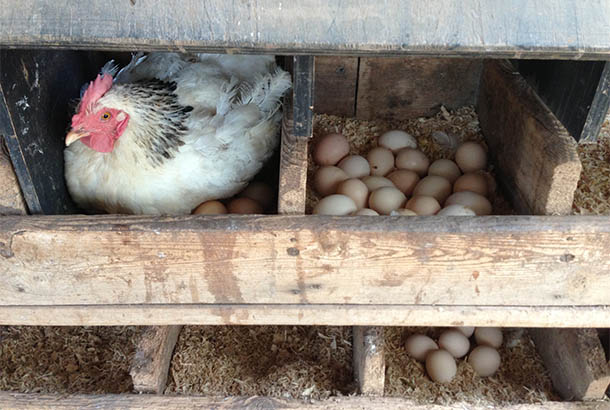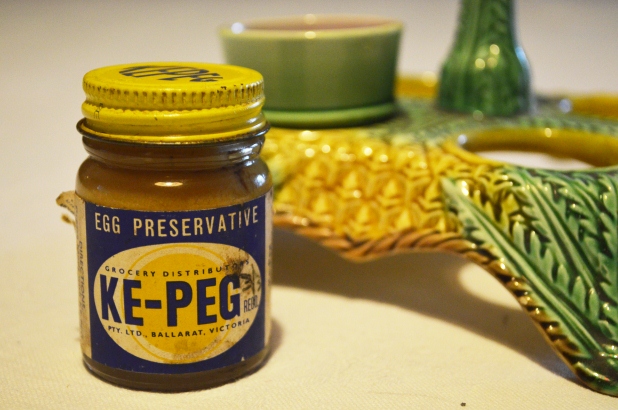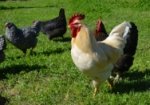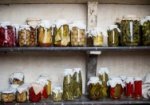Egging? Get it? I know, that was a crack up! Anyway… being Easter time our attentions naturally turn to that most biologically challenging of animals, the Easter Bunny, and eggs!
This is a creature that mysteriously produces not just eggs, but chocolate eggs covered in foil. A neat trick biologically speaking, especially since tradition also indicates he’s male. And a rabbit. Which neatly segues me into the topic of how you go about preserving eggs in the 19th century!
Phenomenal producers
The chickens at Rouse Hill House & Farm today are phenomenal egg producers, and if we forget to collect for a day the broody hens end up atop quite a stack of eggs – the picture below was after a single weekend! And not always their own – as the sneaky ones have a habit of pushing their eggs under the broody hens to be nurtured, while they run off to dig up the garden. But while they’re a veritable production line in summer, in the colder months they stop. And this is where preserving comes in.
Preserving eggs
There are a range of methods of preserving of eggs, often very old techniques, found in many cultures. The common methods are the same for preserving a host of foodstuffs: either change the environment they’re in – by pickling or immersing in brine – or by altering the moisture content – salting or desiccating. If you ever watched M*A*S*H you’ll remember that scrambled eggs reconstituted from a powder were a standard (and often inedible) breakfast dish – usually thrown around the mess tent. I certainly remember them from school camps as being a curiosity more than a delicacy.
The evocatively named ‘Thousand year eggs’ seen in Chinese, Korean and Vietnamese grocers are a far-Eastern standard; Jacqui (The Cook) tells me they taste very salty, and have a rubbery texture, tougher than a boiled egg. Pickled eggs were once common pub food and can still be seen on some menus. Eggs in the fridge will keep for between three to five weeks.
Mrs Beeton gave this advice for preserving eggs for up to three months:
To keep eggs fresh for several weeks:
Have ready a large saucepan, capable of holding 3 or 4 quarts, full of boiling water. Put the eggs into a cabbage-net, say 20 at a time, and hold them in the water (which must be kept boiling) for 20 seconds. Proceed in this manner till you have done as many eggs as you wish to preserve; then pack them away in sawdust. We have tried this method of preserving eggs, and can vouch for its excellence: they will be found, at the end of 2 or 3 months, quite good enough for culinary purposes; and although the white may be a little tougher than that of a new-laid egg, the yolk will be nearly the same… Eggs for storing should be collected in fine weather, and should not be more than 24 hours old when they are packed away, or their flavour, when used, cannot be relied on. Another simple way of preserving eggs is to immerse them in lime-water soon after they have been laid, and then to put the vessel containing the lime-water in a cellar or cool outhouse. Seasonable.– The best time for preserving eggs is from July to September.
Beeton’s Book of Household Management (London, 1861)
She also noted that “Many persons keep eggs for a long time by smearing the shells with butter or sweet oil: they should then be packed in plenty of bran or sawdust, and the eggs not allowed to touch each other”.
The principle behind this technique is that egg shells are not solid but porous, allowing gasses to permeate from the interior to the exterior, and vice-versa. This is the method behind ‘truffle infused eggs’, where eggs are stored in a bag with a truffle, whose rich aroma penetrates and flavors the egg in its unbroken shell. You can do the same with vanilla pods. Coating the shell with a sealant, such as the butter or oil in Beeton’s suggestion, stops the movement of these gasses and aromas. When an egg is fresh it is covered with a ‘bloom’ that impedes this air – and any bacterial – movement. This bloom is lost when the egg is washed.
Ke-peg
This little gem (above) is from the Meroogal collection – another jar is in the collection at Rouse Hill. It’s a vintage bottle of ‘Ke-peg’ which, its manufacturer claimed and as the name suggests, ‘keeps fresh eggs indefinitely preserved in new-laid condition Contents will preserve 25 – 30 doz.[en] eggs.’ Ke-peg was a product of the Great Depression, when every bit helped and food had to go a long way. A 1930s ‘advertorial’ note from the the Brisbane Courier explains further:
KE-PEG EGG PRESERVER.
Each l oz. jar of Ke-Peg egg preserver will preserve about 25 dozen eggs, and each 2oz. jar about 50 dozen eggs. This non-liquid egg preservative, it is stated, combines chemically and harmlessly with the egg shell, and forms a waterproof coating, impermeable to air, and impregnable to bacteria. The manufacturers claim it keeps its preserving qualities from one year to another, and any left over from one season may be used for tho next. Ke-Peg may be obtained from all grocers and stores, the 1oz. Jars selling at 1/9 1/2, and the 20z jars at 3/1.
The Brisbane Courier, 25 August 1931.
It’s an oily coating, applied by greasing your hands then rolling over the egg ’till lightly but thoroughly coated. Eggs should be dry, unwashed and from one to seven days old.’
…much easier these days to pop down the shop.





